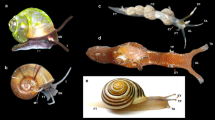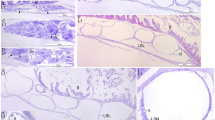Abstract
The embryos and larvae of stalked crinoids, which are considered the most basal group of extant echinoderms1,2, have not previously been described. In contrast, much is known about the development of the more accessible stalkless crinoids (feather stars)3, which are phylogenetically derived from stalked forms4. Here we describe the development of a sea lily from fertilization to larval settlement. There are two successive larval stages: the first is a non-feeding auricularia stage with partly longitudinal ciliary bands (similar to the auricularia and bipinnaria larvae of holothurian and asteroid echinoderms, respectively); the second is a doliolaria larva with circumferential ciliary bands (similar to the earliest larval stage of stalkless crinoids). We suggest that a dipleurula-type larva is primitive for echinoderms and is the starting point for the evolution of additional larval forms within the phylum. From a wider evolutionary viewpoint, the demonstration that the most basal kind of echinoderm larva is a dipleurula is consistent with Garstang's auricularia theory5 for the phylogenetic origin of the chordate neural tube.
This is a preview of subscription content, access via your institution
Access options
Subscribe to this journal
Receive 51 print issues and online access
$199.00 per year
only $3.90 per issue
Buy this article
- Purchase on Springer Link
- Instant access to full article PDF
Prices may be subject to local taxes which are calculated during checkout


Similar content being viewed by others
References
Paul, C. R. C. & Smith, A. B. The early radiation and phylogeny of echinoderms. Biol. Rev. 59, 443–481 (1984)
Janies, D. Phylogenetic relationships of extant echinoderm classes. Can. J. Zool. 79, 1232–1250 (2001)
Holland, N. D. Reproduction of Marine Invertebrates (Echinoderms and Lophophorates) (eds Giese, A. C., Pearse, J. S. & Pearse, V. B.) Vol. 4 247–299 (Boxwood Press, Pacific Grove, California, 1991)
Foote, M. Morphological diversity in the evolutionary radiation of Paleozoic and post-Paleozoic crinoids. Paleobiology 25 suppl. S SPR, 1–115 (1999)
Garstang, W. Preliminary note on a new theory of the phylogeny of the Chordata. Zool. Anz. 17, 122–125 (1894)
Hendler, G. Reproduction of Marine Invertebrates (Echinoderms and Lophophorates) (eds Giese, A. C., Pearse, J. S. & Pearse, V. B.) Vol. 4 355–511 (Boxwood Press, Pacific Grove, California, 1991)
Smiley, S., McEuen, F. S., Chaffee, C. & Krishnan, S. Reproduction of Marine Invertebrates (Echinoderms and Lophophorates) (eds Giese, A. C., Pearse, J. S. & Pearse, V. B.) Vol. 4 663–750 (Boxwood Press, Pacific Grove, California, 1991)
Nielsen, C. Animal Evolution (Oxford Univ. Press, Oxford, 1995)
Strathmann, R. R. Introduction to function and adaptation in echinoderm larvae. Thalass. Jugoslav. 10, 321–339 (1974)
Metschnikoff, E. Über die systematische Stellung von Balanoglassus. Zool. Anz. 4, 139–143 (1881)
Hyman, L. H. The Invertebrates (Echinodermata: The coelomate Bilateria) Vol. 4 (McGraw-Hill, New York, 1955)
Lacalli, T. C. & West, J. E. Ciliary band formation in the doliolaria larva of Florometra I The development of normal epithelial pattern. J. Embryol. Exp. Morph. 96, 303–323 (1986)
Gee, H. Before the Backbone (Chapman & Hall, London, 1996)
Acknowledgements
We thank C. Kitazawa, H. Nakagawa and A. Hirata for technical assistance with scanning electron microscopy, A. Nishino for discussions, and N. D. Holland for reading the manuscript and making valuable comments. This work was supported by grants from The Japan Science Society to Y.H., and from the Sumitomo Foundation and MEXT Japan to S.A.
Author information
Authors and Affiliations
Corresponding author
Ethics declarations
Competing interests
The authors declare that they have no competing financial interests.
Rights and permissions
About this article
Cite this article
Nakano, H., Hibino, T., Oji, T. et al. Larval stages of a living sea lily (stalked crinoid echinoderm). Nature 421, 158–160 (2003). https://doi.org/10.1038/nature01236
Received:
Accepted:
Issue Date:
DOI: https://doi.org/10.1038/nature01236
This article is cited by
-
Brooding comatulids from the southwestern Atlantic, Argentina (Echinodermata: Crinoidea)
Marine Biodiversity (2021)
-
Maternal investment and nutrient utilization during early larval development of the sea cucumber Australostichopus mollis
Marine Biology (2017)
-
The phylogeny, evolutionary developmental biology, and paleobiology of the Deuterostomia: 25 years of new techniques, new discoveries, and new ideas
Organisms Diversity & Evolution (2016)
-
Xenoturbella bocki exhibits direct development with similarities to Acoelomorpha
Nature Communications (2013)
-
Development of an embryonic skeletogenic mesenchyme lineage in a sea cucumber reveals the trajectory of change for the evolution of novel structures in echinoderms
EvoDevo (2012)
Comments
By submitting a comment you agree to abide by our Terms and Community Guidelines. If you find something abusive or that does not comply with our terms or guidelines please flag it as inappropriate.



